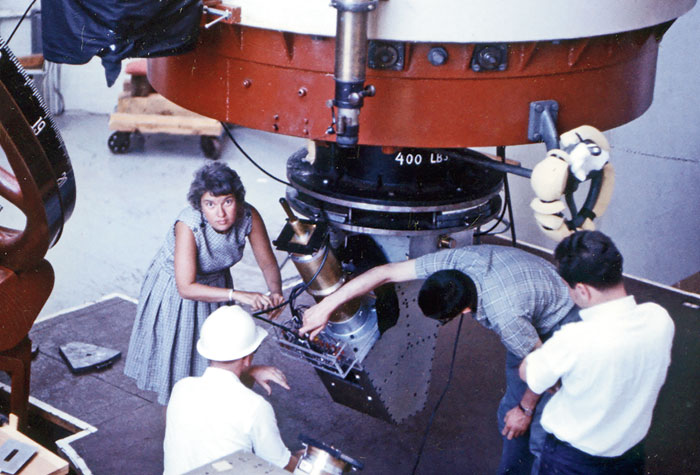Vera Rubin, a young astronomer at the Carnegie Institution in Washington, US, was on the run in the 1970s when she overturned the universe.
Seeking refuge from the controversies and ego-bashing of cosmology, she decided to immerse herself in the pearly swirlings of spiral galaxies, only to find that there was more to them than she and almost everybody else had thought.
For millenniums, humans had presumed that when we gaze out at the universe, what we see is a fair representation of reality. Rubin, with her colleague Kent Ford, discovered that was not true. The universe — all those galaxies and the vast spaces between — was awash with dark matter, an invisible something with sufficient gravity to mold the large scale structures of it.
Esteemed astronomers dismissed her findings at first. But 50 years later, the still futile quest to identify “dark matter” is a burning question for both particle physics and astronomy. It’s a pursuit that stretches from underground particle colliders to orbiting telescopes, with all manner of ground-based observatories in between.
Recently, the National Science Foundation (NSF) announced that the newest observatory joining this cause would be named the Vera C. Rubin Observatory. It replaces the mouthful by which the project was previously known: the Large Synoptic Survey Telescope.
The observatory, jointly financed by the NSF and the US department of energy, under construction on a mountain called Cerro Pachon, in Chile, will begin operating in 2022. By recording images of the entire sky every few days, it will produce a time-lapse movie of the universe.
“Named after an astronomer who provided important evidence of the existence of dark matter,” wrote France Córdova, the foundation’s outgoing director, “the NSF Vera C. Rubin Observatory seems destined to make science history with its extraordinary capabilities that will come to bear in the next few years.”
The Rubin Observatory joins a handful of smaller astronomical facilities that have been named for women. The Maria Mitchell Observatories in Nantucket, Massachusetts, US, is named after the first American woman to discover a comet. The Swope telescope, at Carnegie’s Las Campanas Observatory in Chile, is named after Henrietta Swope, who worked at the Harvard College Observatory in the early 20th century. She used a relationship between the luminosities and periodicities of variable stars to measure distances to galaxies.
And finally there is the new Annie Maunder Astrographic Telescope at the Royal Greenwich Observatory, outside London, UK. It is named after Annie Maunder, who with her husband, Walter, made pioneering observations of the sun and solar cycle of sunspots in the late 1800s.
Heros of science, all of them.
In a field known for grandiloquent statements and frightening intellectual ambitions, Rubin was known for simple statements about how stupid we are. In an interview in 2000 posted on the American Museum of Natural History website, Rubin said: “In a spiral galaxy, the ratio of dark to light matter is about a factor of 10. That’s probably a good number for the ratio of our ignorance to knowledge. We’re out of kindergarten, but only in third grade.”
Once upon a time cosmologists thought there might be enough dark matter in the universe for its gravity to stop the expansion of the cosmos and pull everything back together in a Big Crunch. Then astronomers discovered an even more exotic feature, now called dark energy, which is pushing the galaxies apart and speeding up the cosmic expansion.
These discoveries have transformed cosmology still further, into a kind of Marvel Comics super-struggle between invisible, titanic forces. One, dark matter, pulls everything together toward its final doom; the other, dark energy, pushes everything apart toward the ultimate dispersal, some times termed the Big Rip. The rest of us, the terrified populace looking up at this cosmic war, are bystanders, made of atoms, which are definitely a minority population of the universe. Which force will ultimately prevail? Which side should we root for?
Until recently, the money was on dark energy and eventual dissolution of the cosmos. But lately cracks have appeared in the data, suggesting that additional forces may be at work beneath the surface of our present knowledge.
The discoverers of dark energy won the Nobel Prize in 2011. So far, dark matter has not been so honoured. Rubin was perennially mentioned as a possible candidate for the prize. But she died in 2016, epitomising the consistent failure of the Nobel committee to honour women, and of the general struggle of women in science to receive respect and opportunity.
Once, summoned to a meeting with an eminent astrophysicist, Rubin arrived to be told they would have to talk in the lobby, because women were not allowed upstairs in the offices. Years later, when she finally gained access to the 200-inch Palomar telescope in California, she found there was no women’s restroom. She taped an outline of a skirt over the image of the man on the door, turning it into a ladies’ room.
Now there is an observatory bearing her name. The Rubin Observatory will investigate the cosmic push-pull between dark matter and dark energy, peeling back layers of the sky and of the past. Its data will chart how fast clusters of galaxies (drawn together by dark matter gravity) have grown over cosmic time, and how fast the spaces between these clusters (created by the push of dark energy) have grown as the universe has expanded.
“It is expected to significantly advance what we know about dark matter and dark energy,” Córdova said. “So the Rubin name will have yet another way to inspire women and men eager to investigate.”
Natalie Batalha, an astronomer at the University of California, Santa Cruz, US, who was one of the leaders of Nasa’s Kepler planet-hunting space mission, said, “It’s highly appropriate to see Vera Rubin honoured in this way.”










